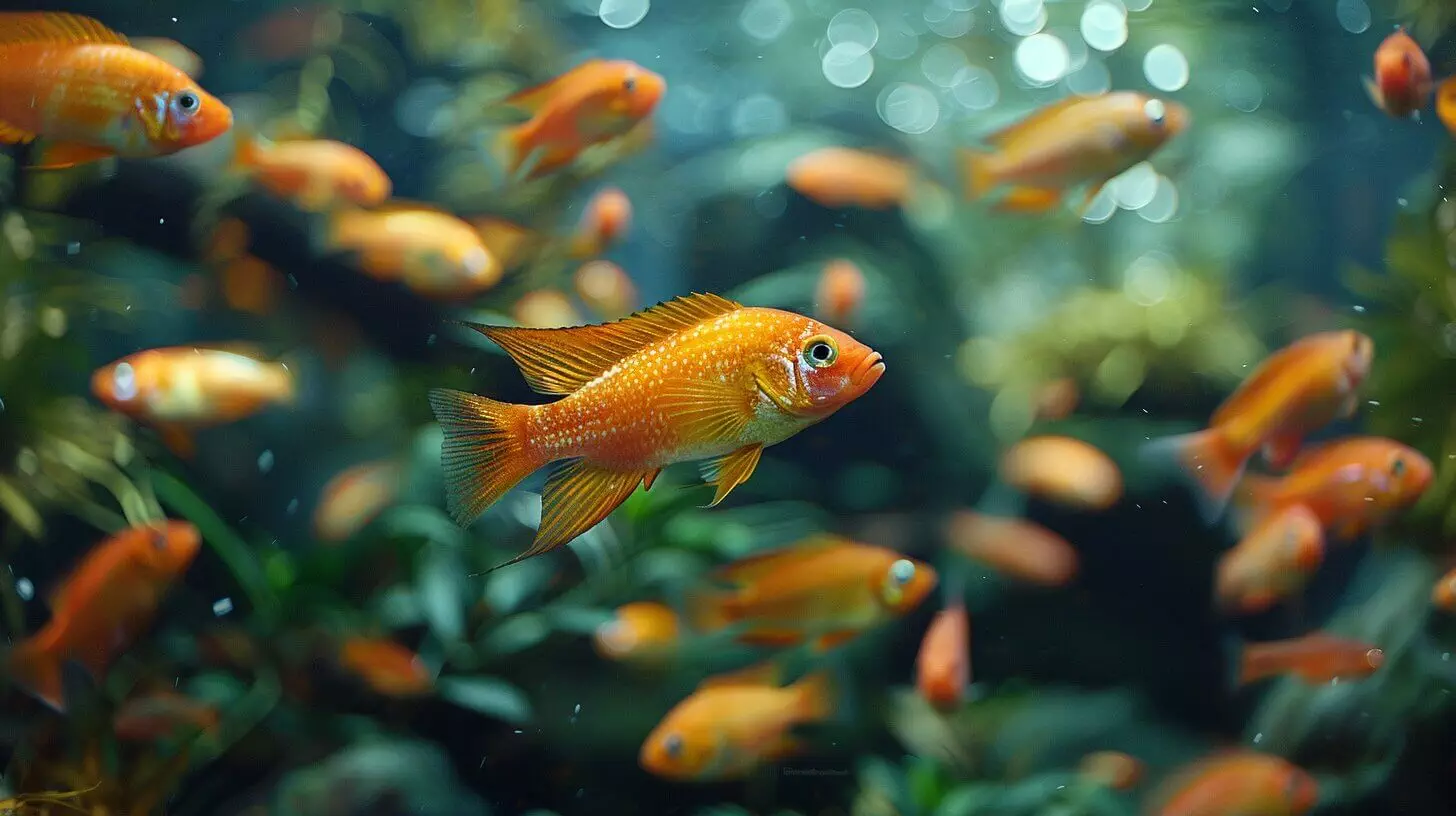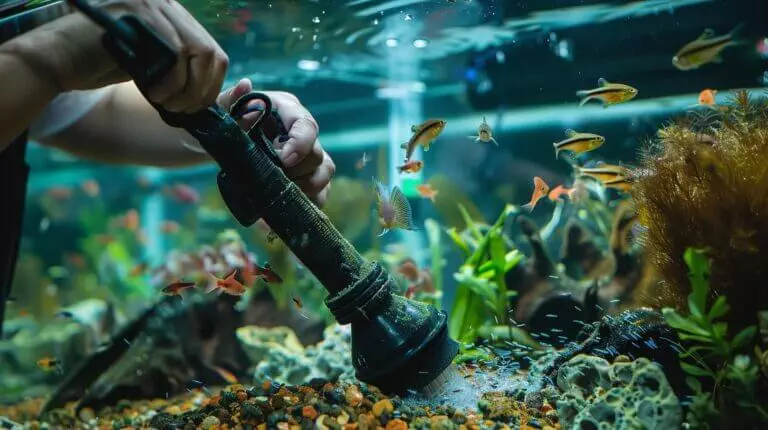As aquarium enthusiasts, we understand how crucial it is to maintain the right pH levels for the health of our fish. Low pH can severely impact our aquatic environment, causing stress and illness in our finned friends. But what exactly leads to this imbalance?
Factors like waste buildup, decaying matter, and even the pH of our tap water can play a role. We might also notice symptoms like gasping at the surface or faded colors. So, how can we effectively monitor and adjust these levels to guarantee a thriving tank? Let’s explore this further.
Key Takeaways
- Poor water quality from waste and decaying matter can cause a low pH in fish tanks.
- Low pH levels can lead to fish stress, lethargy, and color fading.
- Regularly test water pH with a pH meter to monitor for any issues.
- Gradually adjust pH to prevent stress, using natural methods like crushed coral or peat moss, which is an accurate way to measure pH.
- Maintain a clean tank with regular water changes to stabilize pH levels.
Understanding the Importance of pH Level in a Fish Tank

The pH level in a fish tank is essential because it directly impacts the health and well-being of your fish. Different fish species have specific pH tolerance levels. By keeping our fish within their ideal pH range, we ensure a thriving, stress-free environment for them.
If the pH is too high or too low, it can lead to stress and even illness in our aquatic friends. To lower the pH, consider natural methods like adding driftwood or peat moss, or commercial pH-lowering products. Remember, avoid sudden changes as fish need time to adjust to new conditions.
Identifying Symptoms of Low pH in Fish Tanks

When the pH in our fish tank drops too low, physical signs of distress in our fish may be observed. These can include gasping for air at the surface of the water, reduced activity, color fading, and clamped fins – where the fins are held close to the body, signaling stress.
Here are some key symptoms of low pH:
- Gasping at the surface: Fish may struggle to breathe as oxygen levels drop.
- Lethargy: Reduced activity and sluggish movements.
- Color fading: Loss of vibrant colors, appearing dull or washed out, which could be due to not testing the fish to the pH level adequately.
- Clamped fins: Fins held close to the body, indicating stress due to possibly unbalanced aquarium water.
Uncovering the Causes of Low pH in an Aquarium

Many factors can contribute to a drop in pH levels in our aquarium, making it important to understand the root causes to maintain a healthy environment for our fish. One significant factor is water quality. Poor water quality, often due to accumulated waste, uneaten food, and decaying plant matter, can produce acids that lower the pH. Regular water changes and proper filtration can help mitigate this issue.
Another common mistake aquarium owners make isn’t considering that each species has a specific pH requirement. If the pH in the tank is too low for the species we’re keeping, it can lead to stress and health problems. It’s essential to research the ideal pH for our fish and make sure our water parameters match their needs.
The water source we use also plays a significant role. Tap water can vary in pH depending on our location, sometimes contributing to an overly acidic or alkaline aquarium. Additionally, the materials in our tank, such as certain types of rocks or substrate, can alter the pH. For instance, driftwood can release tannins that lower pH, while some rocks can make the water more alkaline.
Monitoring and Adjusting the pH Level in a Fish Tank

Regularly monitoring and adjusting the pH levels in our tank is crucial for the health of our fish. A pH meter provides accurate measurements, and using test kits can validate these readings. If the pH is too low or too high, steps can be taken to adjust it safely. Remember, changes should be gradual to avoid low pH shock.
Here are some key steps to follow:
- Use a pH meter: Provides accurate and quick readings.
- Test the pH regularly: Frequent monitoring helps catch issues early.
- Adjust pH gradually: Avoid sudden changes to prevent low pH shock by finding the most accurate way to measure pH.
- Maintain stability: Consistent pH levels are less stressful for fish.
Preventing Low pH in Fish Tanks Naturally

Preventing low pH in our fish tanks can be achieved through natural methods and diligent tank maintenance. By selecting fish species and plants that thrive at similar pH levels, we can create a harmonious environment.
Certain plants and fish naturally help buffer and maintain pH levels. Natural elements like crushed coral or limestone can stabilize the pH. Regular tank maintenance is also pivotal in maintaining water quality and preventing low pH.
Conclusion
In summary, maintaining a stable pH level in our fish tanks is essential for the health and well-being of our aquatic friends.
By regularly monitoring and addressing symptoms of low pH, we can prevent stress and illness in our fish.
Let’s proactively manage water quality, use natural solutions like crushed coral or peat moss, and make gradual adjustments to keep our aquariums thriving.
Together, we can create a healthy environment for our underwater companions.
Frequently Asked Questions
What causes low pH in a fish tank?
Low pH in a fish tank can be caused by factors such as decaying organic matter, lack of water changes, acidic substrates, or the presence of driftwood. Lower pH levels can also be exacerbated by the use of certain chemical treatments or overfeeding of the fish. Additionally, factors such as the type of fish and plants in the tank can also contribute to a decrease in pH levels. In order to address low pH levels, it may be necessary to consider methods for lowering alkalinity levels in aquarium water, such as using a chemical buffer or adding alkaline substrates to the tank.
What are the effects of low pH on fish?
Low pH can make it difficult for your fish to swim around, affect their ability to breathe, and weaken their immune system, making them more susceptible to diseases; this indicates a need to frequently test the water using different types of pH sensors.
How can I test the pH level in my aquarium?
You can test the pH in your tank using pH probes, pH sensors, or pH test kits available in pet stores. Monitoring the aquarium pH is important to ensure a healthy environment for every fish.
What are some solutions to increase the pH in a fish tank?
You can raise the pH level by adding limestone, crushed coral, baking soda, or commercial pH buffers to the water, offering a way to increase the pH for a more balanced aquarium environment. It’s important to slowly adjust the pH to prevent stress to your fish.
Why is it important to maintain the pH in your aquarium?
The pH of the water directly impacts the health and well-being of your fish. Maintaining a stable pH level ensures that your fish are living in an environment similar to their natural habitat.




